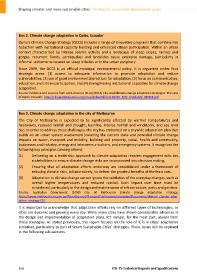Page 568 - Shaping smarter and more sustainable cities - Striving for sustainable development goals
P. 568
Box 2. Climate change adaptation in Quito, Ecuador
Quito's Climate Change Strategy (QCCS) includes a range of innovative programs that combine risk
reduction with institutional capacity building and enhanced citizen participation. Within an urban
context characterized by intense seismic activity and a landscape of steep slopes, ravines and
gorges, recurrent floods, earthquakes and landslides cause extensive damage, particularly in
informal settlements located on steep hillsides or in the urban periphery.
Since 2009, the QCCS is an official municipal environmental policy. It is organized under four
strategic areas: (1) access to adequate information to promote adaptation and reduce
vulnerabilities, (2) use of good environmental practices for adaptation, (3) focus on communication,
education, and citizen participation, and (4) strengthening institutional capacities for climate change
adaptation.
Source: Evidence and Lessons from Latin America (ELLA) (2013) City‐level climate change adaptation strategies: The case
of Quito, Ecuador. http://ella.practicalaction.org/sites/default/files/130225_ENV_CitAdaMit_BRIEF1.pdf
Box 3. Climate change adaptation in the city of Melbourne
The City of Melbourne is expected to be significantly affected by warmer temperatures and
heatwaves, reduced rainfall and drought, bushfire, intense rainfall and windstorm, and sea level
rise. In order to address these challenges, the city has embarked on a citywide adaptation plan that
builds on an urban system assessment (covering the current state and potential climate change
impacts on water, transport and mobility, building and property, social, health and community,
businesses and industry, energy and telecommunications, and emergency systems. It recognizes the
following key principles (among others):
(1) Delivering on a leadership approach to climate adaptation requires engagement with key
stakeholders to ensure climate change risks are incorporated into decision making.
(2) Ensuring that all adaptation efforts underway are consolidated under a framework of
reducing climate risks, collaboratively, to deliver the greatest benefits at the least cost.
(3) Adaptation to climate change cannot ignore the subtleties of the everyday changes, such as
overall higher temperatures and reduced rainfall. Such impact over time must be
considered, particularly in the design and maintenance of infrastructure, parks and gardens.
Source: Australian Government (2009) City of Melbourne climate change adaptation strategy,
https://www.melbourne.vic.gov.au/AboutCouncil/PlansandPublications/strategies/Documents/climate_change_adap
tation_strategy.PDF
It is important to acknowledge that adaptation efforts rely on different types of technologies, as
cities are dynamic and growing every day. While many cities have shown considerable advances in
the design and implementation of adaptation plans, ICT remain, for the most part, absent from
those strategies. As stated previously, this report focuses on the role of ICTs in cities' adaptation
initiatives, particularly as part of Smart Sustainable Cities' strategies. These issues will be explored
in the following sub‐sections.
558 ITU‐T's Technical Reports and Specifications

